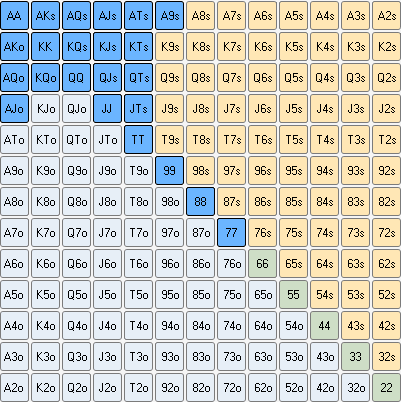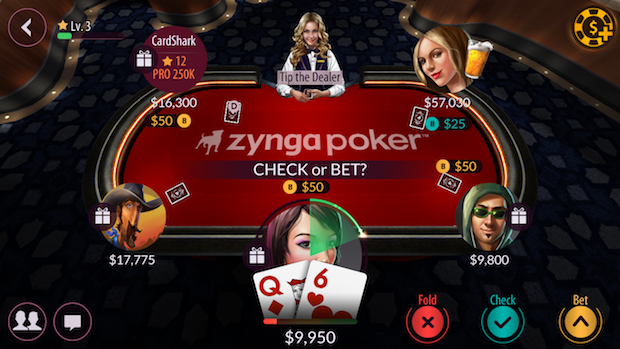Best Starting Hands In Texas Holdem Poker
Posted By admin On 30/03/22- Top 20 Best Starting Hands For Texas Holdem Poker
- Best Starting Hands In Texas Hold'em Poker
- Top 10 Best Starting Hands In Texas Hold'em Poker
- Follow these hand charts and learn how to play your starting hands at Texas Holdem. The charts below will give you a great starting point on how to play your starting hands. For all of you beginners, we recommend consulting these charts will playing online. We provide 4 separate charts depending on where you are seated relative to the dealer.
- Top 10 Best Starting Hands In Texas Hold'em Poker. 3 Pocket Queens. 4 Ace-King Suited. 7 Ace-Queen Suited. 8 Ace-King Offsuit.
- This hand, which is also referred to as American Airlines is the best starting hand pre flop out of all potential starting hands in Texas Hold'Em Poker. With a hand like this, betting more aggressively is advised. The King, King starting hand is the second best starting hand pre-flop when it comes to Texas Hold'Em Poker.
To play the game you need to know which texas holdem starting hands are the best to start the game with. We have thus far provided you with a beginner’s guide to playing Texas hold em along with an ultimate poker hand ranking guide where we listed the different possible 5-card poker hands you can have playing games such as Texas hold’em and Omaha.
Starting Hand Selection:Chen Formula : Sklansky Starting Hand Groups
The Sklansky & Malmuth starting hands table.
| Group | Hands |
|---|---|
| 1 | AA, AKs, KK, QQ, JJ |
| 2 | AK, AQs, AJs, KQs, TT |
| 3 | AQ, ATs, KJs, QJs, JTs, 99 |
| 4 | AJ, KQ, KTs, QTs, J9s, T9s, 98s, 88 |
| 5 | A9s - A2s, KJ, QJ, JT, Q9s, T8s, 97s, 87s, 77, 76s, 66 |
| 6 | AT, KT, QT, J8s, 86s, 75s, 65s, 55, 54s |
| 7 | K9s - K2s, J9, T9, 98, 64s, 53s, 44, 43s, 33, 22 |
| 8 | A9, K9, Q9, J8, J7s, T8, 96s, 87, 85s, 76, 74s, 65, 54, 42s, 32s |
| 9 | All other hands not required above. |
This table comes from the book Hold 'em Poker for Advanced Players by David Sklansky and Mason Malmuth.
This is a strategy book for limit Hold'em, but the starting hand groups do have some practical use in no limit Hold'em.
What is the Sklansky and Malmuth starting hands table?
The table is a general ranking of hands in Texas Hold'em.
The Sklansky and Malmuth starting hands table groups together certain hands in Texas Hold'em based on their strength. Starting with the strongest set of hands that you can be dealt in group 1, the hands get progressively weaker working down the table until the virtually unplayable hands in group 9.
The rough idea is that a hand in one group has roughly the same value and can be played the same way preflop as any other hand in that group.
How to use the starting hands table.
In their book, Sklansky and Malmuth provide some in-depth guidelines for starting hand strategy in limit Texas Hold'em using this table. Unfortunately, I'm not going to work out any guidelines for you for the NL Hold'em game using this table because:
- It would be quite a tricky job.
- It would be difficult to remember and implement.
- Like any starting hand strategy, it would have its flaws.
- You should avoid using strict guidelines and set rules as much as possible during play.
So really there is not a lot to take away from this table from a purely strategic perspective. Nonetheless it's interesting to see how specific starting hands compare to one another based on their preflop value.
If you're really after a starting hand strategy guideline, try the Chen Formula.
Sklansky and Malmuth hand rankings evaluation.
Although it's a very popular hand group rankings table, it's not going to do you too much good to learn the whole thing off by heart. In my opinion, the real value of this table is being able to see how different starting hands can be grouped together and ranked based on their value before the flop.
For other useful charts and tables, see the odds charts page from the Texas Hold'em tools section.
Go back to the awesome Texas Hold'em Strategy.
Comments
Fundamentals of Poker - Limit Texas Hold'em Mason MalmuthTwo Plus Two Magazine, Vol. 8, No. 12
Mason MalmuthTwo Plus Two Magazine, Vol. 8, No. 12- General Guidelines
- Seven Card Stud
- Limit Texas Hold'em
There are five categories of limit hold ’em starting hands that we will discuss: Big pairs, small and medium pairs, two high cards, suited connectors, and big-little suited. Most other hands should be thrown away unless you have the big blind and the pot has not been raised.
Big pairs.
A pair of tens and higher is an excellent starting hand. With a high pair, you not only can make an even bigger hand, but also can completely miss the board — your hand does not improve — and still have a reasonable opportunity to win the pot. Obviously, the chances of winning with two aces are better than the chances of winning with two tens. In general, however, all high pairs have immediate value and should be played aggressively.
Small and medium pairs.
In hold ’em, as in seven-card stud, there is a big difference in strength between big pairs and smaller pairs. A hand like the
seldom wins the pot without improvement. Moreover, the odds against this hand improving to three of a kind on the flop are almost 8-to-1 (although you still can flop a straight draw).
Since small and medium pairs rarely win without improving, they have little immediate value and therefore can be classified as drawing hands. And to profitably play these hands, you need several opponents in the pot.
Two high cards.
Two unsuited high cards is usually a playable hand but not a great hand. Even though ace-king almost always should be played, a hand like theoften should be folded, especially if someone has raised. In addition, this hand must hit the flop to win in a multiway pot.
If your hand is suited, you should be more inclined to play. But remember the warning given earlier: Don’t overrate the value of two suited cards.
Suited connectors.
 Hands like the
Hands like theare only fair at best. And if your hand contains a gap, you cannot play it as often since your straight possibilities have decreased. This type of hand usually should be thrown away in early position, and you should not call a raise even from a late position unless many players are already in the pot.
Big-little suited.
An ace or a king with a small card of the same suit is similar in value to the suited connectors and should be played as such. Of course ace-little suited is better than king-little suited.
Starting Hand Quiz
1. What hands are you primarily interested in playing?
Big pairs and high cards, especially suited high cards.
2. How do you play these hands?
Aggressively. Almost always raise, and with the better hands, usually reraise.
Top 20 Best Starting Hands For Texas Holdem Poker

3. Suppose two players are already in the pot. The first player has raised, the second has called, and you hold two kings. What should you do?
Raise again. You have a strong hand and would prefer to shut out the remaining players.
4. In what situation do small pairs play best?
In a many-handed pot.
Best Starting Hands In Texas Hold'em Poker
5. When you play a small pair, what are you hoping to do?
Top 10 Best Starting Hands In Texas Hold'em Poker
To make three of a kind on the flop.
6. When do suited connectors play best?

When many opponents are in the pot.
7. You are in one of the blind positions, someone has raised, and there are several callers. What kind of hands should you play?
All of the good hands, plus all pairs and many of the hands that can make straights and flushes.
8. Which hand is better, ace-jack offsuit or eight-seven suited?
Normally, ace-jack offsuit is the better hand. But when a lot of players are in the pot, you would prefer to hold the eight-seven suited. In this spot, don’t overplay a hand like ace-jack.
9. If there is no raise, what hands do you call with out of the little blind?
Even though you can get in for only a partial bet, you still need to be somewhat selective. Routinely playing hands like the
eventually will prove costly. In other words, you still should discard your worst hands.
10. If someone has raised, how does this affect the hands you should play?
Generally, you need to be much more selective. Small pairs and medium suited connectors do not play well against a large pair, and when someone raises, he’s quite likely to be holding a large pair. In addition, a raise makes it doubtful that a lot of players will enter the pot. This means you will not get the implied odds — the amount of money you anticipate winning versus the amount you expect it to cost you — that many hands require to be profitable.
11. When should you play a hand like king-four suited?
When you are in a late position, several players are already in, and the pot has not been raised.
12. When you have a close decision regarding whether to play a hand, what should you consider?
In hold ’em, as in seven-card stud and all other forms of poker, you must take into account how well those opponents already in the pot play. The better they play, the less inclined you should be to go up against them.
Poker Strategy and Other Topics - November 2019
by Carlos Welch
by Robert Samuels
by Kevin Haney
by Kevin Haney
by Ben Saxton
by Bryan Clark
by Felipe Garcia, CFA and Aaron Byrd, CFA
by Nick Willett
by Mason Malmuth